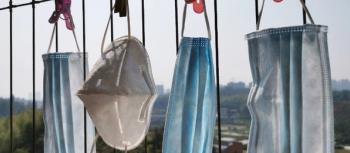
Frontlines Dispatch: This Infection Preventionist Takes Managing COVID-19 a Day at a Time
Too often infection prevention work feels thankless, but the truth is that we are the backbone in this situation and now is the time that people really see that.
This is a tough time. There’s no other way of saying it for those of us in healthcare and infection prevention. Every day brings new challenges and at this point, it often seems as if we’re going from putting out one fire as another begins. While guidance changes and the US healthcare response moves more to the model of saturation, here are some general findings and thoughts in the midst of this pandemic.
As more people get tested, we will see more cases. That’s a given. Part of this means that staff and healthcare workers will be exposed in the community and potentially when caring for patients. It is likely that moving away from contact tracing and exposure evaluation will occur and instead we will have to rely on staff symptom checks and not working when they are sick. Meaning that everyone has a critical role in acknowledging signs and symptoms and staying home to isolate and avoid further transmission.
Healthcare workers are scared. Everyone is at a heightened level of stress and worry as stores, restaurants, and many businesses are temporary closed to reduce further transmission and support social distancing. This is a bizarre time and while it will likely be a while before the US moves past it, it is important that we support and lean on each other.
Infection preventionists should rely on support systems-meet with leadership and encourage transparency. Talk to staff and use those moments training when training about using personal protection equipment (PPE) and isolation precautions, to also answer questions.
Re-using and extended use of N95 masks is something most healthcare workers likely never experienced and goes against nearly everything infection preventionists have drilled into on them over the years. Explain that things might change but that everyone is working hard to keep them safe and why isolation precautions are unique in this situation, but ultimately these are skills they’ve had for years.
Establish a process for information sharing. Daily meetings with leaders and sharing of the suspected or confirmed COVID-19 cases, goes a long way. Continued conversations ensure everyone is on the same page and questions are being answered real-time.
As everyone adapts to this new situation there will be modifications to make guidance work and ensure staff and patients are safe. Transparency means trust and right now, healthcare workers need to know they can trust their infection prevention team.
Take care of yourself. This might sound lofty as so many have been working nearly 24/7 for weeks or months now. This is not a sprint, but rather a marathon and so much of our private and home lives are being impacted. Take the time to establish guidance for staff that can be used instead of calling you for everything. You need a break. Rounding in the morning and before the end of the day helps answer a lot of questions that might have resulted in a late-night call.
Too often infection prevention work feels thankless, but the truth is that we are the backbone in this situation and now is the time that people really see that. This is the moment that infection prevention shines and it may not be perfect … in fact it’ll be messy and at times frustrating, but stay the course.
Take those quiet moments if you can-eat lunch outside or talk about something other than COVID-19 as it feels that’s all we talk about lately. Infection preventionists and our efforts are so critical right now and it is important people understand that so much of this is new for us all but if we work together, we can flatten the curve for us all.
Newsletter
Stay prepared and protected with Infection Control Today's newsletter, delivering essential updates, best practices, and expert insights for infection preventionists.




